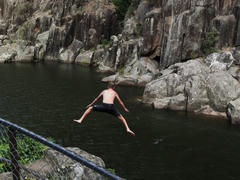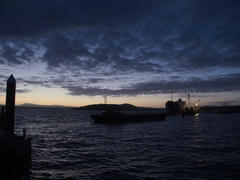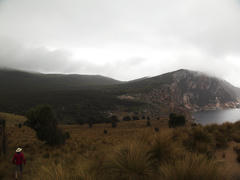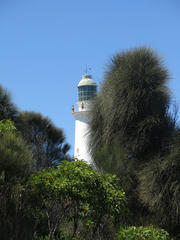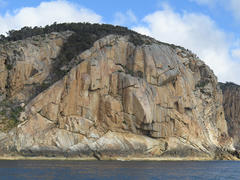Fair-weather sailing is underrated. As we nosed our way into the Bass Strait and waves began to wash over the deck, I couldn't help but ponder the truth in the words from our skipper. Sailing in good weather, I have discovered, leaves plenty of time for reflection between brief moments excitement. As we journey under the darkening sky, out into the willowing sea I begin to wonder what sailing in bad weather is like…

After a mysterious email, an exciting phone call, and a short flight to Hobart I was on board a boat with a “desperate a bunch of daring individuals” for an adventure of unknown quantity. With almost no experience sailing, while stepping aboard the Kaileia in Constitution Harbour I couldn’t help but feel out of place. I got to know Dick and Lloyd as we wheeled a shopping trolley heavily loaded with goods recently acquired from the nearby supermarket, supplies to feed us on our journey around the west coast of Tasmania. Dick left his job for the promise of a sailing adventure with his old friend Jack, our skipper. Lloyd is an enthusiastic mechanical engineer, who found out about this trip the same way I did. Over the course of the day I would discover that despite our wildly varying levels of sailing experience, one thing the crew of 6 held in common was that we were all climbers.
Our first night of the journey was spent in Oyster Cove near Kettering. French explorer Nicolas Baudin had this to say about the area when he travelled down the Derwent River in 1802:
“It is most extraordinary, to see that these dense forests, ancient daughters of nature and time, where the noise of the axe is never heard and where the vegetation is richer every day from its own products, can extend unimpeded everywhere; and when at the other end of the world one happens to see forests exclusively composed of trees unknown in Europe, of plants strange in form and various in their productions, one’s interest becomes more keen and more pronounced.”
There are a lot more houses and roads there these days, but still to come were the hundreds of kilometers of virtually untouched wilderness coastline in South West Tasmania, which I think we were all very excited to see first hand.

On this particular night, Dick had figured the Kaileia was parked in the same cove as his friend Jim Duff. There was an invitation to join him for a late supper. Having spotted Jim’s boat in the twilight, we piled into the dingy and departed in its general direction. Crouching and bouncing in the dark, it was hard for me to shake the feeling and beating heart; this was like a commando raid on an enemy ship. Climbing aboard his boat, we were greeted and invited to join Jim in his parlour down below. I stepped over the threshold from the windy, dark water, into Jim’s heated, Nepalese rug decorated parlour. The contrast was a heady experience and it left quite an impression on me. Soon we were joined by a friendly French couple who had arrived several hours after us. Conversation would reveal that the couple had been travelling the world for over 20 years in their yacht, recently arrived in Tasmania from New Zealand. Jim also had stories to tell from his years adventuring and climbing. As he brought out his climbing rack upon request to show us some of his vintage climbing nuts the question presented itself: what is it about sailing and climbing which draws us to them?
Muscles, winding, creaking and flapping. Sails are up for our second leg to Recherche Bay, and the engine’s off. It’s hard to describe the pride one feels when switching off the engine and doing battle with the wind to attain our goal. H. W. Tilman puts it eloquently - “For that man who travels by his own exertions, no day is dull and no journey without an abiding interest”. Tilman was a character often referred to on the boat. With some amazing and almost forgotten accomplishments, this sailor/climber was adventurous right until the end when he disappeared in the Southern Atlantic at the age of 80. Perhaps something to secretly aspire to.
The third leg of the trip was spectacular. With the wind behind us as we rounded the point and headed north, it was easy sailing, and wave surfing all the way up to Port Davey. The sun was shining, and the coastline put on a show, such as I have never seen before. Jagged rocks of many colours, standing proud amidst the waves slowly passed us by. In the distance, white granite outcrops on impressive inland peaks glittered in the afternoon light. At the far end of Port Davey, an opening like a river, once followed, leads to the improbable expanse of Bathurst Harbour.

While the others set off to explore the tiny settlement of Melaleuca, I stayed behind to help watch the boat and read books about sailing. Progress was made on technique with our friend the macerator. Soon after stepping on the Kaileia, it was evident that the macerator was a running joke amongst all present on the boat. Stan has written a poem about it, which was recited to me, with many laughs, after my first prolonged encounter with the device. Designed to suck sewage out of the ship’s toilet, the subtle changes in tone as the macerator processes its bounty are heard by all on board. Throughout the course of the trip, we witnessed many battles waged in the small confines of the toilet, the helpless victim desperately mashing the button and urging the macerator to overcome the traffic jams without manual intervention!

We spent several days in the vicinity of Port Davey, and on the final day we found ourselves, as climbers, irresistibly drawn to the granite spikes of Mt Stokes looming above our anchorage in Bramble Cove. We landed on a small sandy beach, as close as we could to the base of the mountain. A thick wall of Tasmanian scrub lay between us and our goal in the sky, which was swiftly being encroached by clouds. Bush-bashing was more than I had bargained for; this trip was quickly turning into a proper adventure. Clear of the scrub, we climbed up through folds of rock, slime and grass towards the ridge. Puzzles on steep rock provided entertainment for the climbers, though not enough for Dick, who longed to be over on the next spur where it was even steeper! If I had to pick one word to describe what I found, and now look for in climbing, it would be visceral. That deep connection between yourself, your partner, and your environment which cuts through any distractions and puts you squarely in the moment. I found some similar moments while sailing; when the waves are crossing the deck, ropes are flapping, and the horizon tilts wildly. The crew is working together to pull down and reef a sail. Wind and spray are in their faces and they are trying not to topple overboard. Sailing can certainly be a visceral experience.

Sailing north on an early alpine start, and we passed the lights of fishermen braving the waves, almost too close to rocks for my comfort. As we neared the aptly named Hell’s Gates with the tall white lighthouse decorating the horizon, we began to celebrate the return to civilisation. But Peter, who is an airline pilot gave his word of caution, “it’s not over until the wheels are on the tarmac and the engines stop turning”. 30 seconds later, “What the #*@# is that!?” shouts Jack who slams the wheel hard left to avoid an unfortunate encounter with some rocks just under the surface. So small were they that they had not been observed on our map. With hearts still in mouths, we approached the infamous entrance of Hell’s Gates and Macquarie Harbour. The penal station in Macquarie Harbour had the reputation of being the worst in Australia. Prisoners attempted murder, to be tried and hung in order to avoid a return to this place. The channel is narrow, and rocky, so we slowed down to a crawl, and motored through.

Travelling from Strahan to the north coast of Tasmania was to be our first overnight leg. As the sun set, and we began our watch, Jack told us horror stories of yachts being run down by container ships. No doubt the thought of that happening helped to keep us awake and aware late in the night. Of this night I recorded in my journal: “Sail to north coast, overnight full moon and dolphin jumping, silhouetted and shiny against the dark ocean. Best moment of my life.”. “It’s nights like these that trick you into buying a yacht” says Jack staring out over the moonlit scene.
"what solitude is more complete, or more poetical than that of a ship floating in isolation on the sea during the obscurity of the night, in the silence of immensity, and under the eye of heaven?" A. Dumas - The Count of Monte Cristo.

With half the crew leaving us at Beauty Point, the job of getting across the Bass Strait and back to Sydney was left to Jack, Dick and myself. Sleep is harder to come by with only 3 on on board. We decided to take our overnight watches in 1 hour stints, leaving 2 hours in between for sleeping. We began our journey across the Bass Strait by hugging the coast in search of the early morning southerly, cold air flowing off the land. Eventually this dissipated and a north easterly wind dictated that we beat into the wind in order to reach our destination, Flinders Island. By the third tack, progress, we realised, was slow. It was going to take two days at this rate. A hefty decision was made by the skipper after consulting the weather charts on his phone that we should instead reach north, straight for Deal Island and the Kent Group. I jumped for joy inside, having secretly hoped all along we could visit those islands to check them out for future expeditions.
With a 22 knot wind blowing, it would be lying if I said that the Bass Strait crossing to the Kent Group was a thoroughly enjoyable experience. All three of us probably had some sea sickness, with it slowly rearing its head as the day progressed. Waves crossed from several directions making life onboard a little more chaotic. Jack mentioned that the entire Strait is not more than 100m in depth, which contributes to it's reputation of wild waves. As the day wore on, I managed to eat only a muesli bar and an apple. The others fared similarly. It seemed that no-one particularly wanted to or was hungry enough to venture below decks in an expedition to prepare and retrieve a meal for those ailing above. Bravely, Dick took the risk and made us some soup. Through a window above I watched the soup pot toss wildly on the stove. While Dick was bent over cooking, and I couldn't help but admire his culinary courage as he braced himself against the walls. It was a good feed, I think we all agreed. The dolphins arrived to play during my turn at the wheel, frollicking and jumping in the twilight hour. I wonder what makes dolphins follow boats, do they know there are people on board? Is this show of acrobatic prowess for our entertainment and admiration?
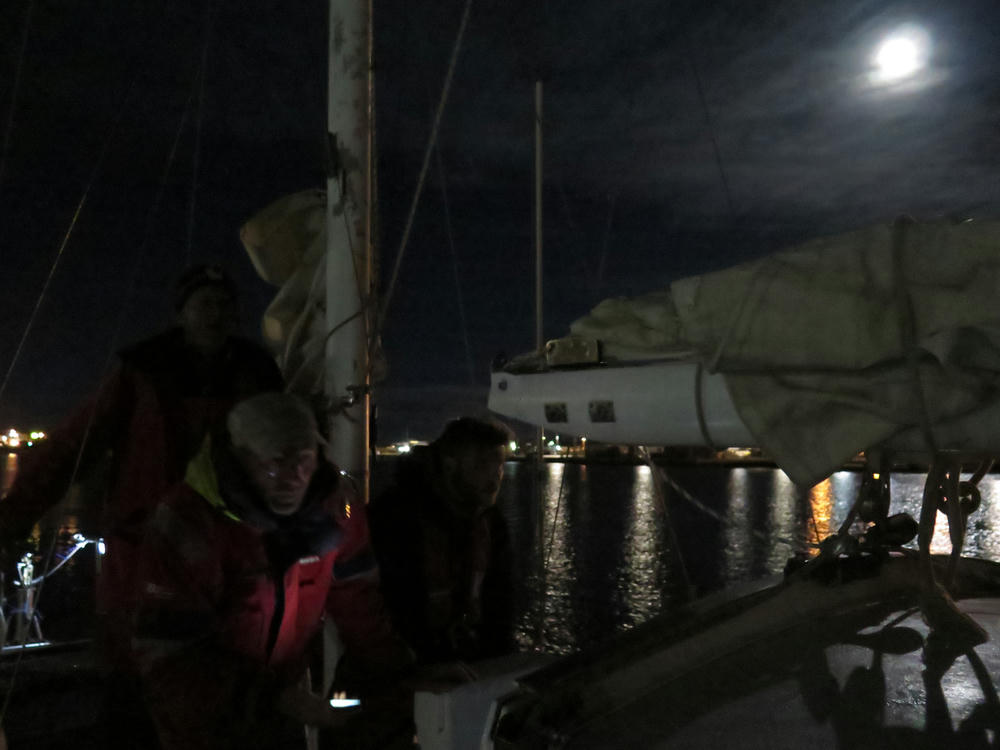
The sky was overcast, and as the sun fell below the horizon the world around us grew dark. Within an hour it was completely black. The lights are kept off to enable us to better spot other ships. It’s a scary thing not being able to see what’s out there, or anticipate each approaching wave. The next could be a monster and you wouldn’t know until it hit. At 11pm the shape of the Kent Group formed in front, half a shade darker than the rest. Using the radar on the mast, we navigated into the channel between the islands. With Dick as our token “scared sailor” sitting and listening on the bow, we hoped to have a better chance of avoiding obstacles unseen. As West Cove on Deal island opened out on our right, a light suddenly appeared, floating in the void. With no reference to its distance from us, we approached cautiously and suddenly discovered we had company in the form of another boat. After spending almost an hour trying to get the anchor to stick, sleep finally came, not having any idea what this place looked like.

In the morning, peering out of the cabin at an unknown landscape, mist and drizzle were not enough to overcome our excitement and desire to land and explore. Dick and I pulled the dinghy ashore and secured it to some rocks above the sand. Scattered on the track up the hill were dozens of wallabies. To my surprise, they didn’t move as we approached. On numerous occasions throughout my stay on Deal Island I was startled to look down from my camera, and find a wallaby innocently staring up at me. Perhaps a lack of predator for many generations has led to this? As we toured the islands, I think perhaps both Jack and Dick caught some of my enthusiasm for a future visit as they were pointing out features in the rock. Hopefully next time I’ll come with a climbing rack.
The wind we were waiting for had swung westerly, and our brief visit to the Kent Group was over. Out again at the mercy of the Bass Strait. The oil and gas rigs lit up the night sky from afar, and our boat left a phosphorescent wake. Another night anchored off Gabo Island and we arrived at Eden.
It was sad to say goodbye to the Kaileia, and I hope one day to sail again with her. As the queasiness wears off, all that is left are fond memories of a most unexpected and fortunate adventure.
“There is something in common between the arts of sailing and of climbing. Each is intimately concerned with elemental things, which from time to time demand from men who practise those arts whatever self-reliance, prudence, and endurance they may have. The sea and the hills offer challenges to those who venture upon them and in the acceptance of these and in the meeting of them as best he can lies the sailor’s or mountaineer’s reward.” - H. W. Tilman, Mischief in Patagonia
Short Film
This is a short film I made from footage taken on the trip: https://vimeo.com/144355555




























